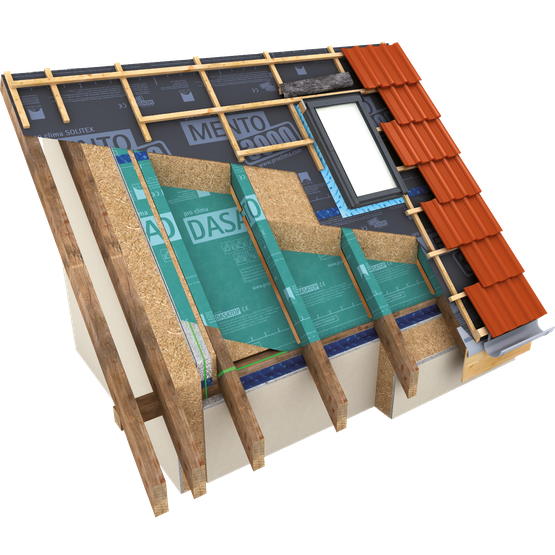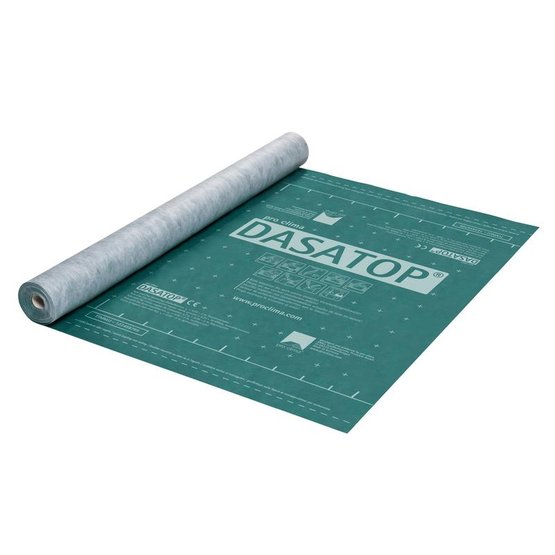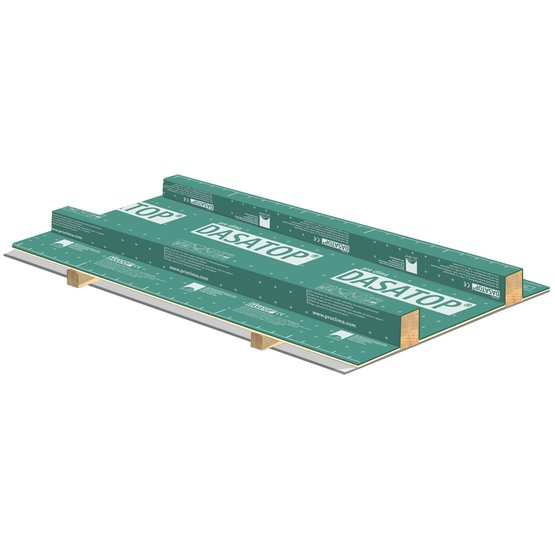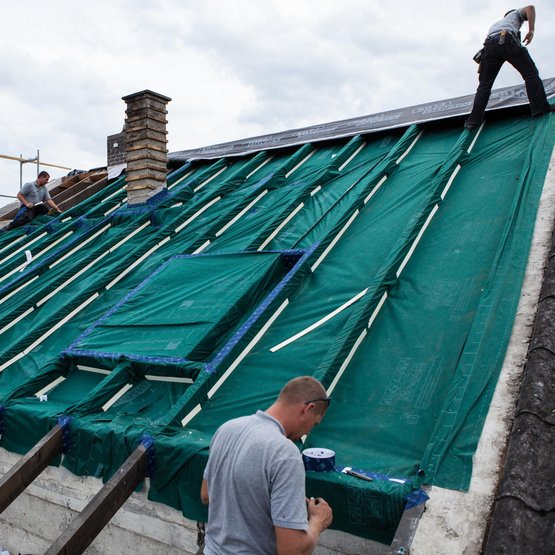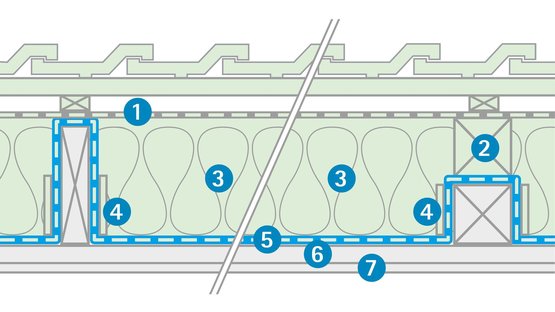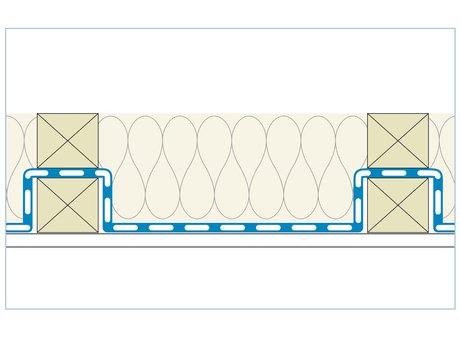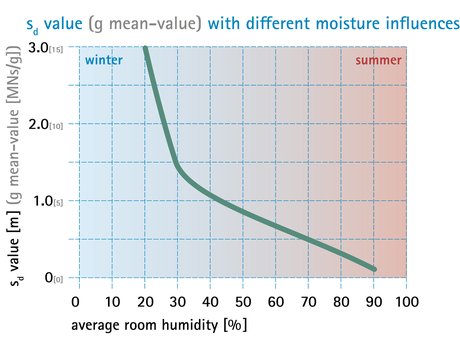Retrofit Vapour Control Layer
Advantages
- Airtightness installed from the outside
- Specifically developed for roof restoration
- Humidity-variable MVTR
- No additional airtight joints required at the rafters
- High tear resistance due to fleece reinforcement
Areas of application
DASATOP® is an air-resistive barrier for installation over rafters and across sarking in roof renovation projects. Installed from the outside, DASATOP® protects structures from rain wetting during construction while cladding is removed.
Planning and construction guidelines
Areas of application
The DASATOP vapour control (alternate term: vapour check) membrane, which can be subjected to outdoor exposure, can be used on refurbishment projects as follows:
- This membrane is optimised for installation into the spaces between the rafters and over the rafters
- On structures that are open to diffusion on the outside
‘Sub-and-top’ solution with DASATOP
- Roofing underlay membrane, e.g. SOLITEX MENTO 3000
- Reinforcement rafter
- Fibrous insulation material
- Continuous linear contact ensured, e.g. with DASATOP FIX mounting strips
- DASATOP
- Service cavity, if applicable
- Inner lining e.g. Tongue and Groove board
Possible combinations of insulation materials
Optimal protection for building structures can be achieved with the DASATOP system if the following conditions are met:
- External roof insulation with fibrous insulation material
- Roofing underlay membranes that are open to diffusion on the outside (e.g. the SOLITEX MENTO series), also over roof sheathing, and
- Wood-fibre
A combination with foam insulation materials should only be used as a covering if: - Drying out of the structure to the outside is ensured, and - This combination is installed in the pitched roof area, but not on uppermost ceilings/floors underneath unheated attic spaces
In general, DASATOP cannot be used on structures that have diffusion-tight component layers on the outside.
4 weeks of outdoor exposure
DASATOP can be subjected to outdoor exposure for up to 4 weeks to protect the building structure. Please note that DASATOP does not provide sealing that is equivalent to an emergency roof. Moisture can enter at staples or other perforations (nails, screws etc.). Drainage of water across adjacent building structures must be ensured. Additional covering with tarpaulins is recommended for buildings that people are still living in or that are particularly worthy of protection (e.g. historical or listed buildings).
Use of fibrous insulation materials
Fibrous insulation materials are ideal. Moisture must be able to penetrate as far as the vapour control membrane in order for the humidity-variable properties of DASATOP to have an impact. Diffusion-open insulation materials ensure that this is the case and are recommended for this reason.
- If blown-in insulation is used, DASATOP must be in contact (supported) across the entire area of the inner cladding.
- DASATOP can also be combined with fleece-laminated foam insulation materials as an additional insulation covering (for greater than 50 mm thickness) if the structure is open to diffusion to the outside. However, this is only possible in the pitched roof area, but not on uppermost ceilings/floors underneath unheated attic spaces. WUFI software check recommended.
Installation under reinforcement beams:
If the depth of the rafters is to be increased, it is recommended to first install DASATOP and then fit the reinforcement rafter. In this way, the airtightness layer is positioned on the warmer side of the structure, which is favourable from a construction physics viewpoint.
Use possible on structures that are open to diffusion on the outside
Diffusion-open roofing underlay membranes (e.g. SOLITEX roofing membranes) protect the structure during the construction phase and provide the required windtightness. They can also be installed onto solid-wood sheathing. Permeable insulation panels made of wood-based products can be added to any arbitrary thickness above the rafters (eg. Gutex wood fibre boards).
Inner lining
In principle, all inner lining typically used in construction are permitted. Excluded are building structures with additional external roof insulation with foam insulation materials (slow diffusion behaviour). In this case, no diffusion-inhibiting layers such as OSB or multi-layer wooden panels may be positioned on the inside of the insulation so as to ensure reliable drying out.
Increased indoor humidity
The diffusion resistance of DASATOP has been designed to ensure that there is a reliable vapour-controlling effect in the case of typical indoor humidities, even in bathrooms and kitchens.
Quality assurance
In the case of membrane installation on the exterior, efficient quality assurance can be carried out during the course of construction by means of differential pressure testing with overpressure and artificial fog. As part of this testing, fog is generated inside the building using a fog machine. In this way, the airtightness of detail features can be checked and rectified on the exterior. The membranes must be mechanically secured to a sufficient extent beforehand. For this reason, adhesive taping and all joints are to be implemented with particular care.
Detailed construction planning – particularly of joints at the eaves and gable ends and the implementation of these joints on roof refurbishment projects – is particularly important.
Optimal drying conditions
Protection thanks to a low MVTR: If sub-and-top membranes are not in ideal contact with the rafters, convection tunnels may be formed.
They can compromise the protection provided, but often cannot be avoided in practice.
Accordingly, it is important in the context of protection against damage to structures that membranes are extremely open to diffusion so that they can quickly transport larger quantities of moisture to the outside.
The variable diffusion resistance of DASATOP has been chosen to be ideal for quick sub-and-top installation.
Technical support
If you have questions relating to planning and installation, please contact pro clima Technical Support.



